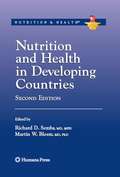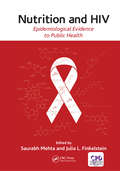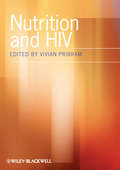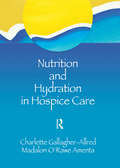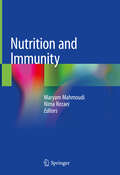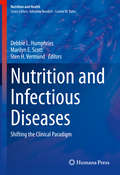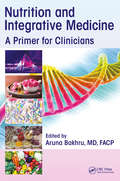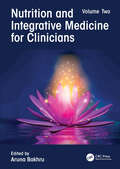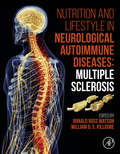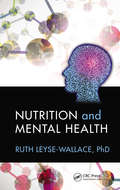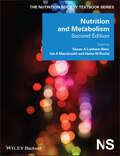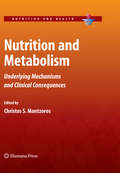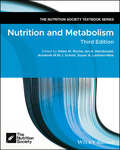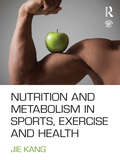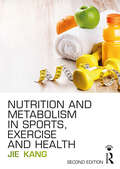- Table View
- List View
Nutrition and Health in Developing Countries (Nutrition and Health)
by Richard D. Semba Martin W. BloemThis updated and expanded book was written with the underlying conviction that global health and nutrition problems can only be solved through a firm understanding of the different levels of causality and the interactions between the various determinants. This volume provides policy makers, nutritionists, students, scientists, and professionals with the most recent and up-to-date knowledge regarding major health and nutritional problems in developing countries.
Nutrition and HIV: Epidemiological Evidence to Public Health
by Saurabh Mehta Julia FinkelsteinThe world continues to lose more than a million lives each year to the HIV epidemic, and nearly two million individuals were infected with HIV in 2017 alone. The new Sustainable Development Goals, adopted by countries of the United Nations in September 2015, include a commitment to end the AIDS epidemic by 2030. Considerable emphasis on prevention of new infections and treatment of those living with HIV will be needed to make this goal achievable. With nearly 37 million people now living with HIV, it is a communicable disease that behaves like a noncommunicable disease. Nutritional management is integral to comprehensive HIV care and treatment. Improved nutritional status and weight gain can increase recovery and strength of individuals living with HIV/AIDS, improve dietary diversity and caloric intake, and improve quality of life. This book highlights evidence-based research linking nutrition and HIV and identifies research gaps to inform the development of guidelines and policies for the United Nations’ Sustainable Development Goals. A comprehensive approach that includes nutritional interventions is likely to maximize the benefit of antiretroviral therapy in preventing HIV disease progression and other adverse outcomes in HIV-infected men and women. Modification of nutritional status has been shown to enhance the quality of life of those suffering HIV/AIDS, both physically in terms of improved body mass index and immunological markers, and psychologically, by improving symptoms of depression. While the primary focus for those infected should remain on antiretroviral treatment and increasing its availability and coverage, improvement of nutritional status plays a complementary role in the management of HIV infection.
Nutrition and HIV: Epidemiological Evidence to Public Health
by Saurabh Mehta Julia FinkelsteinThe world continues to lose more than a million lives each year to the HIV epidemic, and nearly two million individuals were infected with HIV in 2017 alone. The new Sustainable Development Goals, adopted by countries of the United Nations in September 2015, include a commitment to end the AIDS epidemic by 2030. Considerable emphasis on prevention of new infections and treatment of those living with HIV will be needed to make this goal achievable. With nearly 37 million people now living with HIV, it is a communicable disease that behaves like a noncommunicable disease. Nutritional management is integral to comprehensive HIV care and treatment. Improved nutritional status and weight gain can increase recovery and strength of individuals living with HIV/AIDS, improve dietary diversity and caloric intake, and improve quality of life. This book highlights evidence-based research linking nutrition and HIV and identifies research gaps to inform the development of guidelines and policies for the United Nations’ Sustainable Development Goals. A comprehensive approach that includes nutritional interventions is likely to maximize the benefit of antiretroviral therapy in preventing HIV disease progression and other adverse outcomes in HIV-infected men and women. Modification of nutritional status has been shown to enhance the quality of life of those suffering HIV/AIDS, both physically in terms of improved body mass index and immunological markers, and psychologically, by improving symptoms of depression. While the primary focus for those infected should remain on antiretroviral treatment and increasing its availability and coverage, improvement of nutritional status plays a complementary role in the management of HIV infection.
Nutrition and HIV
by Vivian PribramToday over 40 million adults and children worldwide are infected with HIV, however knowledge of the disease has increased greatly and the prognosis is now good for those with access to anti-retroviral treatment. For many, HIV is now a long-term chronic condition and with decreased mortality, patient requirements and disease patterns have changed, making it increasingly apparent to health care professionals that the treatment of HIV should include optimum nutrition and healthy lifestyle interventions to help sufferers lead long and healthy lives. In this essential new book an international team of authors under the editorship of Specialist HIV Dietitian Vivian Pribram bring together the latest research to provide the practicing dietitian and nutritionist with a practical guide to the nutritional care of the HIV and AIDS patient. Students and other health care professionals working and studying this area will also find Nutrition and HIV an important and valuable resource.
Nutrition and HIV
by Vivian PribramToday over 40 million adults and children worldwide are infected with HIV, however knowledge of the disease has increased greatly and the prognosis is now good for those with access to anti-retroviral treatment. For many, HIV is now a long-term chronic condition and with decreased mortality, patient requirements and disease patterns have changed, making it increasingly apparent to health care professionals that the treatment of HIV should include optimum nutrition and healthy lifestyle interventions to help sufferers lead long and healthy lives. In this essential new book an international team of authors under the editorship of Specialist HIV Dietitian Vivian Pribram bring together the latest research to provide the practicing dietitian and nutritionist with a practical guide to the nutritional care of the HIV and AIDS patient. Students and other health care professionals working and studying this area will also find Nutrition and HIV an important and valuable resource.
Nutrition and Hydration in Hospice Care: Needs, Strategies, Ethics
by Charlette Gallagher-Allred Madalon O'Rawe AmentaThis scholarly book enables health care professionals to appropriately address hospice patients’and families’concerns about nutrition and hydration. Nutrition and Hydration in Hospice Care is a comprehensive resource that provides hands-on practical information that readers can use in everyday hospice practice. The chapters identify problems, solutions, and ethical issues of nutrition and hydration in hospice care.The contributing authors provide the way for health care professionals, especially those in nursing, dietary, and pharmacy units, to jointly and effectively manage troublesome symptoms and ethical issues. The following topics are included in the scope of coverage: nutrition/hydration needs during end-stage disease nursing and dietary roles in identifying nutrition/hydration problems and implementing treatment how needs of dying children and adults are different legal and ethical dilemmas of withholding or withdrawing nutrition and hydration appropriate and inappropriate uses of enteral and parenteral nutrition support during end-stage diseases food service considerations in inpatient hospice facilities appetite stimulant use in palliative careBecause Nutrition and Hydration in Hospice Care is comprehensive, all members of hospice staffs can find practical information to use each day. The authors cover issues not found in other books for nurses, dietitians, pharmacists, and physicians. They will find the information ready to apply at their work settings.
Nutrition and Hydration in Hospice Care: Needs, Strategies, Ethics
by Charlette Gallagher-Allred Madalon O'Rawe AmentaThis scholarly book enables health care professionals to appropriately address hospice patients’and families’concerns about nutrition and hydration. Nutrition and Hydration in Hospice Care is a comprehensive resource that provides hands-on practical information that readers can use in everyday hospice practice. The chapters identify problems, solutions, and ethical issues of nutrition and hydration in hospice care.The contributing authors provide the way for health care professionals, especially those in nursing, dietary, and pharmacy units, to jointly and effectively manage troublesome symptoms and ethical issues. The following topics are included in the scope of coverage: nutrition/hydration needs during end-stage disease nursing and dietary roles in identifying nutrition/hydration problems and implementing treatment how needs of dying children and adults are different legal and ethical dilemmas of withholding or withdrawing nutrition and hydration appropriate and inappropriate uses of enteral and parenteral nutrition support during end-stage diseases food service considerations in inpatient hospice facilities appetite stimulant use in palliative careBecause Nutrition and Hydration in Hospice Care is comprehensive, all members of hospice staffs can find practical information to use each day. The authors cover issues not found in other books for nurses, dietitians, pharmacists, and physicians. They will find the information ready to apply at their work settings.
Nutrition and Immunity
by Maryam Mahmoudi Nima RezaeiThis volume provides readers with a systematic assessment of current literature on the link between nutrition and immunity. Chapters cover immunonutrition topics such as child development, cancer, aging, allergic asthma, food intolerance, obesity, and chronic critical illness. It also presents a thorough review of microflora of the gut and the essential role it plays in regulating the balance between immune tolerance and inflammation. Written by experts in the field, Nutrition and Immunity helps readers to further understand the importance of healthy dietary patterns in relation to providing immunity against disorders and offering readily available immunonutritional programming in clinical care. It will be a valuable resource for dietitians, immunologists, endocrinologists and other healthcare professionals.
Nutrition and Infectious Diseases: Shifting the Clinical Paradigm (Nutrition and Health)
by Debbie L. Humphries Marilyn E. Scott Sten H. VermundThis comprehensive and user-friendly volume focuses on the intersection between the fields of nutrition and infectious disease. It highlights the importance of nutritional status in infectious disease outcomes, and the need to recognize the role that nutrition plays in altering the risk of exposure and susceptibility to infection, the severity of the disease, and the effectiveness of treatment. Split into four parts, section one begins with a conceptual model linking nutritional status and infectious diseases, followed by primers on nutrition and immune function, that can serve as resources for students, researchers and practitioners. Section two provides accessible overviews of major categories of pathogens and is intended to be used as antecedents of pathogen-focused subsequent chapters, as well as to serve as discrete educational resources for students, researchers, and practitioners. The third section includes five in-depth case studies on specific infectious diseases where nutrition-infection interactions have been extensively explored: diarrheal and enteric disease, HIV and tuberculosis, arboviruses, malaria, and soil-transmitted helminths. The final section addresses cross-cutting topics such as drug-nutrient interactions, co-infections, and nutrition, infection, and climate change and then concludes by consolidating relevant clinical and public health approaches to addressing infection in the context of nutrition, and thus providing a sharp focus on the clinical relevance of the intersection between nutrition and infectionWritten by experts in the field, Nutrition and Infectious Diseases will be a go to resource and guide for immunologists, clinical pathologists, sociologists, epidemiologists, nutritionists, and all health care professionals managing and treating patients with infectious diseases.
Nutrition and Integrative Medicine: A Primer for Clinicians
by Aruna BakhruWhile medical professionals continue to practice traditional allopathic medicine, the public has turned toward nutritional and integrative medical therapies, especially for addressing the proliferation of chronic diseases. Written by leaders in the academic and scientific world, Nutrition and Integrative Medicine: A Primer for Clinicians presents various modalities to help restore health. This book provides users with a guide to evaluating and recommending nutritional and integrative therapies. The book offers insights on the microbiome of the human body, examines the relationship of human health to the microbiome of the food we ingest, and introduces the concept of "food as information." It provides enlightenment on anti-aging and healing modalities, mind–body medicine, and an investigation of psychological trauma as related to disease causation. Integrative therapies, including water, light, and sound therapy, are explored, and information on healing chronic disease through nutrition, the tooth–body connection, the role of toxins in disease causation, and electromagnetic field hypersensitivity, as well as its management, is presented.
Nutrition and Integrative Medicine: A Primer for Clinicians
by Aruna BakhruWhile medical professionals continue to practice traditional allopathic medicine, the public has turned toward nutritional and integrative medical therapies, especially for addressing the proliferation of chronic diseases. Written by leaders in the academic and scientific world, Nutrition and Integrative Medicine: A Primer for Clinicians presents various modalities to help restore health. This book provides users with a guide to evaluating and recommending nutritional and integrative therapies. The book offers insights on the microbiome of the human body, examines the relationship of human health to the microbiome of the food we ingest, and introduces the concept of "food as information." It provides enlightenment on anti-aging and healing modalities, mind–body medicine, and an investigation of psychological trauma as related to disease causation. Integrative therapies, including water, light, and sound therapy, are explored, and information on healing chronic disease through nutrition, the tooth–body connection, the role of toxins in disease causation, and electromagnetic field hypersensitivity, as well as its management, is presented.
Nutrition and Integrative Medicine for Clinicians: Volume Two
by Aruna BakhruMystery illness can be helped, and this book lays the groundwork for it! Can a water-damaged building ruin your health and cause debilitating exhaustion, chronic pain, insomnia, anxiety, obesity and "brain fog?" Could a flood or wet basement make you sick even if it has long dried out? Building on its predecessor, Nutrition and Integrative Medicine for Clinicians: Volume Two is an essential, peer-reviewed resource for practitioners to help patients with various illnesses found in society, including those contracted from water-damaged structures, that can lay the groundwork for a healthy road to recovery. Written by authors at the forefront of their respective fields, this book presents information for people "written off" as having a "mystery illness," fibromyalgia or chronic fatigue. Chronic inflammatory response syndrome (CIRS) is ubiquitous and affects many body systems, yet it is largely unrecognized by doctors, who misdiagnose CIRS patients daily. This book is a comprehensive guide on evaluating illnesses that are difficult to diagnose, including CIRS. This volume contains information on various subjects, including: Illnesses resulting from water-damaged buildings and subsequent change in the microbiome of the building. Steps to heal from mold/mycotoxin illnesses. Legal and ethical considerations in health issues from exposure to a water-damaged building as well as introducing the "building science" to clinicians. Effects of CIRS on metabolism and insulin resistance. Environmental hormone disruptors. Myalgic encephalitis/chronic fatigue syndrome. Regenerative agriculture. Pediatric sleep-related breathing disorders and their effects on growth and development. Circadian effects of artificial light and their effects on mitochondria. Nutritional support in Covid. The design nature of sound and its relationship to neural networks. The human body as a biological sound healing instrument. The use of color in clinical application. Art in medicine. Living life with intentionality and mindfulness. Making childbirth a positive experience.
Nutrition and Integrative Medicine for Clinicians: Volume Two
by Aruna BakhruMystery illness can be helped, and this book lays the groundwork for it! Can a water-damaged building ruin your health and cause debilitating exhaustion, chronic pain, insomnia, anxiety, obesity and "brain fog?" Could a flood or wet basement make you sick even if it has long dried out? Building on its predecessor, Nutrition and Integrative Medicine for Clinicians: Volume Two is an essential, peer-reviewed resource for practitioners to help patients with various illnesses found in society, including those contracted from water-damaged structures, that can lay the groundwork for a healthy road to recovery. Written by authors at the forefront of their respective fields, this book presents information for people "written off" as having a "mystery illness," fibromyalgia or chronic fatigue. Chronic inflammatory response syndrome (CIRS) is ubiquitous and affects many body systems, yet it is largely unrecognized by doctors, who misdiagnose CIRS patients daily. This book is a comprehensive guide on evaluating illnesses that are difficult to diagnose, including CIRS. This volume contains information on various subjects, including: Illnesses resulting from water-damaged buildings and subsequent change in the microbiome of the building. Steps to heal from mold/mycotoxin illnesses. Legal and ethical considerations in health issues from exposure to a water-damaged building as well as introducing the "building science" to clinicians. Effects of CIRS on metabolism and insulin resistance. Environmental hormone disruptors. Myalgic encephalitis/chronic fatigue syndrome. Regenerative agriculture. Pediatric sleep-related breathing disorders and their effects on growth and development. Circadian effects of artificial light and their effects on mitochondria. Nutritional support in Covid. The design nature of sound and its relationship to neural networks. The human body as a biological sound healing instrument. The use of color in clinical application. Art in medicine. Living life with intentionality and mindfulness. Making childbirth a positive experience.
Nutrition and Lifestyle in Neurological Autoimmune Diseases: Multiple Sclerosis
by Ronald Ross Watson William D. KillgoreNutrition and Lifestyle in Neurological Autoimmune Diseases: Multiple Sclerosis discusses important discoveries relating to the types of, and efficacy of, nutritional and lifestyle responses to symptoms and reoccurrence of MS. Each chapter defines a new approach to use in foods, dietary supplements, exercise, behavior, and/or lifestyle in health promotion and symptoms management for MS. This book presents the role of non-pharmaceutical approaches and is essential reading for neurologists, physicians, nurses, nutritionists, dietitians, healthcare professionals, research scientists, biochemists, and general practitioners.Presents a comprehensive overview that details the role of nutrition and exercise in Multiple SclerosisWritten for researchers and clinicians in neurology, neuroscience, and exercise and nutritionDefines a new approach that focuses on foods, dietary supplements, exercise, behavior, and lifestyle in health promotion and symptoms management for MS
Nutrition and Mental Health
by Ruth Leyse-WallaceAlthough primary advanced vitamin and mineral deficiencies are rare in the developed world, many common health conditions deplete nutritional status, including sub-optimal dietary intake, frequent alcohol consumption, changes in appetite due to aging, food allergies or sensitivities, special diets, and eating disorders. Covering topics as diverse a
Nutrition and Metabolism
by Susan A. Lanham-New Ian A. MacDonald Helen M. RocheNutrition and Metabolism Second Edition Edited by Susan A Lanham-New, Ian A Macdonald and Helen M Roche EditionIn this second edition of the second title in the acclaimed Nutrition Society Textbook Series, Nutrition and Metabolism has been revised and updated to meet the needs of the contemporary student. Groundbreaking in their scope and approach, the titles in the series: Provide students with the required scientific basics of nutrition in the context of a systems and health approach Enable teachers and students to explore the core principles of nutrition, to apply these throughout their training, and to foster critical thinking at all times. Throughout, key areas of knowledge are identified Are fully peer-reviewed, to ensure completeness and clarity of content, as well as to ensure that each book takes a global perspective Nutrition and Metabolism is an essential purchase for students of nutrition and dietetics, and also for those students who major in other subjects that have a nutrition component, such as food science, medicine, pharmacy and nursing. Professionals in nutrition, dietetics, food science, medicine, health sciences and many related areas will also find much of great value within its covers.
Nutrition and Metabolism: Underlying Mechanisms and Clinical Consequences (Nutrition and Health)
by Christos S. MantzorosNutrition and Metabolism: Underlying Mechanisms and Clinical Consequences brings together internationally recognized experts to comprehensively review our current understanding of how nutrition interacts with the genetic substrate as well as environmental-exogenous factors, including physical activity or the lack thereof, to result in insulin resistance and the metabolic syndrome. After presenting the scope of the problem, the first major part of the book is devoted to genetics and pathophysiology, the second part of the book presents the public health perspective of the most prevalent problems associated with nutrition and the metabolic syndrome, whereas the third major part of the book focuses on clinical assessment and management of the main disease states associated with inappropriate nutrition and the metabolic syndrome. Finally, general information useful for both clinicians and researchers alike is presented in the Appendix. Nutrition and Metabolism: Underlying Mechanisms and Clinical Consequences offers the reader an up-to-date and authoritative review of the major scientific and clinical aspects of the overlapping areas between nutrition and metabolism.
Nutrition and Metabolism (The Nutrition Society Textbook)
by Helen M. Roche Ian A. Macdonald Annemie M.W.J. Schols Susan A. Lanham-NewComprehensive resource on all aspects of nutrition and metabolism; covering vitamin and mineral deficiencies, diseases, immunity, brain and bone health, and more. Now in its third edition, Nutrition and Metabolism has been updated throughout to present readers with the core principles of nutrition in the context of a systems and health approach. Written by a team of internationally renowned experts, the text includes information on: Body composition, energy metabolism, proteins, amino acids, carbohydrates, lipids, vitamins, minerals, trace elements, food intake, and food composition Energy, macronutrients, pregnancy and lactation, growth and aging, brain nutrition, sensory systems and food palatability, the gastrointestinal system, and the cardiovascular system Societal food choices, over- and undernutrition, eating disorders, dieting, foetal programming, cancer, osteoporosis, and diabetes How nutrition affects the liver, pancreas, kidney, lungs, heart and blood vessels, and how nutrition relates to the development of traumatic, infectious, and malignant diseases Nutrition and Metabolism is an essential resource for students and practitioners of nutrition and dietetics, as well as students majoring in other subjects that have a nutrition component.
Nutrition and Metabolism (The Nutrition Society Textbook)
by Helen M. Roche Ian A. Macdonald Annemie M. W. J. Schols Susan A. Lanham-NewComprehensive resource on all aspects of nutrition and metabolism; covering vitamin and mineral deficiencies, diseases, immunity, brain and bone health, and more. Now in its third edition, Nutrition and Metabolism has been updated throughout to present readers with the core principles of nutrition in the context of a systems and health approach. Written by a team of internationally renowned experts, the text includes information on: Body composition, energy metabolism, proteins, amino acids, carbohydrates, lipids, vitamins, minerals, trace elements, food intake, and food composition Energy, macronutrients, pregnancy and lactation, growth and aging, brain nutrition, sensory systems and food palatability, the gastrointestinal system, and the cardiovascular system Societal food choices, over- and undernutrition, eating disorders, dieting, foetal programming, cancer, osteoporosis, and diabetes How nutrition affects the liver, pancreas, kidney, lungs, heart and blood vessels, and how nutrition relates to the development of traumatic, infectious, and malignant diseases Nutrition and Metabolism is an essential resource for students and practitioners of nutrition and dietetics, as well as students majoring in other subjects that have a nutrition component.
Nutrition and Metabolism (The Nutrition Society Textbook #5)
by Susan A Lanham-New Ian A Macdonald Helen M RocheNutrition and Metabolism Second Edition Edited by Susan A Lanham-New, Ian A Macdonald and Helen M Roche EditionIn this second edition of the second title in the acclaimed Nutrition Society Textbook Series, Nutrition and Metabolism has been revised and updated to meet the needs of the contemporary student. Groundbreaking in their scope and approach, the titles in the series: Provide students with the required scientific basics of nutrition in the context of a systems and health approach Enable teachers and students to explore the core principles of nutrition, to apply these throughout their training, and to foster critical thinking at all times. Throughout, key areas of knowledge are identified Are fully peer-reviewed, to ensure completeness and clarity of content, as well as to ensure that each book takes a global perspective Nutrition and Metabolism is an essential purchase for students of nutrition and dietetics, and also for those students who major in other subjects that have a nutrition component, such as food science, medicine, pharmacy and nursing. Professionals in nutrition, dietetics, food science, medicine, health sciences and many related areas will also find much of great value within its covers.
Nutrition And Metabolism In Sports, Exercise And Health
by Jie KangA key determinant of successful athletic performance is the high-level energy transformation which begins with combustion of the food that we eat. By developing a sound understanding of good nutrition we can improve athletic performance, help maintain good health and prevent disease. This clear and comprehensive introduction to nutrition in sport, exercise and health goes further than any other textbook in integrating key nutritional facts, concepts and dietary guidelines with a thorough discussion of the fundamental biological science underpinning our physiological and metabolic processes. By clearly explaining how nutrients function within our biological system, the book helps students to develop a better understanding of the underlying mechanisms, which, in turn, will help the student to apply their knowledge in practice. The book includes in depth discussion of key contemporary topics within nutrition including: nutrient bioenergetics nutrition and metabolic disease nutritional ergogenic aids nutrition for special populations nutritional assessment. Each chapter includes useful pedagogical features, including case studies, review questions, definitions of key terms, and practical laboratory exercises #65533; such as techniques for assessing nutritional status, body composition and physical activity patterns. A companion website offers additional teaching and learning features, such as PowerPoint slides, multiple-choice question banks and web links. As the most up-to-date introduction to sport and exercise nutrition currently available, this book is essential reading for all students of sport and exercise science, kinesiology, physical therapy, nutrition, dietetics or health sciences. Visit the companion website at www. routledge. com/cw/kang
Nutrition and Metabolism in Sports, Exercise and Health
by Jie KangA key determinant of successful athletic performance is the high-level energy transformation which begins with combustion of the food that we eat. By developing a sound understanding of good nutrition we can improve athletic performance, help maintain good health and prevent disease. This clear and comprehensive introduction to nutrition in sport, exercise and health goes further than any other textbook in integrating key nutritional facts, concepts and dietary guidelines with a thorough discussion of the fundamental biological science underpinning our physiological and metabolic processes. By clearly explaining how nutrients function within our biological system, the book helps students to develop a better understanding of the underlying mechanisms, which, in turn, will help the student to apply their knowledge in practice. The book includes in depth discussion of key contemporary topics within nutrition including: nutrient bioenergetics nutrition and metabolic disease nutritional ergogenic aids nutrition for special populations nutritional assessment. Each chapter includes useful pedagogical features, including case studies, review questions, definitions of key terms, and practical laboratory exercises – such as techniques for assessing nutritional status, body composition and physical activity patterns. A companion website offers additional teaching and learning features, such as PowerPoint slides, multiple-choice question banks and web links. As the most up-to-date introduction to sport and exercise nutrition currently available, this book is essential reading for all students of sport and exercise science, kinesiology, physical therapy, nutrition, dietetics or health sciences. Visit the companion website at www.routledge.com/cw/kang
Nutrition and Metabolism in Sports, Exercise and Health
by Jie KangA key determinant of successful athletic performance is the high-level energy transformation which begins with combustion of the food that we eat. By developing a sound understanding of good nutrition we can improve athletic performance, help maintain good health and prevent disease. This clear and comprehensive introduction to nutrition in sport, exercise and health goes further than any other textbook in integrating key nutritional facts, concepts and dietary guidelines with a thorough discussion of the fundamental biological science underpinning our physiological and metabolic processes. By clearly explaining how nutrients function within our biological system, the book helps students to develop a better understanding of the underlying mechanisms, which, in turn, will help the student to apply their knowledge in practice. The book includes in depth discussion of key contemporary topics within nutrition including: nutrient bioenergetics nutrition and metabolic disease nutritional ergogenic aids nutrition for special populations nutritional assessment. Each chapter includes useful pedagogical features, including case studies, review questions, definitions of key terms, and practical laboratory exercises – such as techniques for assessing nutritional status, body composition and physical activity patterns. A companion website offers additional teaching and learning features, such as PowerPoint slides, multiple-choice question banks and web links. As the most up-to-date introduction to sport and exercise nutrition currently available, this book is essential reading for all students of sport and exercise science, kinesiology, physical therapy, nutrition, dietetics or health sciences. Visit the companion website at www.routledge.com/cw/kang
Nutrition and Metabolism in Sports, Exercise and Health
by Jie KangThe second edition of Nutrition and Metabolism in Sports, Exercise and Health offers a clear and comprehensive introduction to sport and exercise nutrition, integrating key nutritional facts, concepts and dietary guidelines with a thorough discussion of the fundamental biological science underpinning physiological and metabolic processes. Informed by the latest research in this fast-moving discipline, the book includes brand-new sections on, amongst others: • Cellular structure for metabolism • Alcohol and metabolism • Uncoupling protein and thermogenesis • Dietary guidelines from around the world • Nutrient timing • Protein synthesis and muscle hypertrophy • Protein supplementation • Ergogenic effects of selected stimulants • Nutritional considerations for special populations • Dehydration and exercise performance Each chapter includes updated pedagogical features, including definitions of key terms, chapter summaries, case studies, review questions and suggested readings. A revised and expanded companion website offers additional teaching and learning features, such as PowerPoint slides, multiple-choice question banks and web links. No book goes further in explaining how nutrients function within our biological system, helping students to develop a better understanding of the underlying mechanisms and offering the best grounding in applying knowledge to practice in both improving athletic performance and preventing disease. As such, Nutrition and Metabolism in Sports, Exercise and Health is essential reading for all students of sport and exercise science, kinesiology, physical therapy, strength and conditioning, nutrition or health sciences.
Nutrition and Metabolism in Sports, Exercise and Health
by Jie KangThe second edition of Nutrition and Metabolism in Sports, Exercise and Health offers a clear and comprehensive introduction to sport and exercise nutrition, integrating key nutritional facts, concepts and dietary guidelines with a thorough discussion of the fundamental biological science underpinning physiological and metabolic processes. Informed by the latest research in this fast-moving discipline, the book includes brand-new sections on, amongst others: • Cellular structure for metabolism • Alcohol and metabolism • Uncoupling protein and thermogenesis • Dietary guidelines from around the world • Nutrient timing • Protein synthesis and muscle hypertrophy • Protein supplementation • Ergogenic effects of selected stimulants • Nutritional considerations for special populations • Dehydration and exercise performance Each chapter includes updated pedagogical features, including definitions of key terms, chapter summaries, case studies, review questions and suggested readings. A revised and expanded companion website offers additional teaching and learning features, such as PowerPoint slides, multiple-choice question banks and web links. No book goes further in explaining how nutrients function within our biological system, helping students to develop a better understanding of the underlying mechanisms and offering the best grounding in applying knowledge to practice in both improving athletic performance and preventing disease. As such, Nutrition and Metabolism in Sports, Exercise and Health is essential reading for all students of sport and exercise science, kinesiology, physical therapy, strength and conditioning, nutrition or health sciences.
